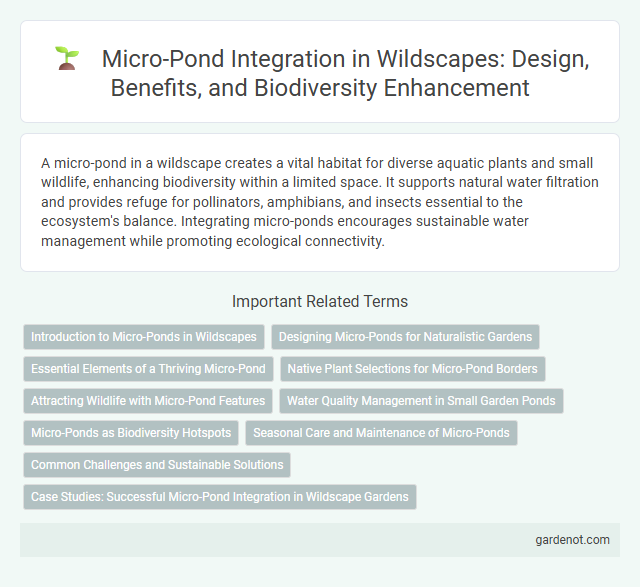A micro-pond in a wildscape creates a vital habitat for diverse aquatic plants and small wildlife, enhancing biodiversity within a limited space. It supports natural water filtration and provides refuge for pollinators, amphibians, and insects essential to the ecosystem's balance. Integrating micro-ponds encourages sustainable water management while promoting ecological connectivity.
Introduction to Micro-Ponds in Wildscapes
Micro-ponds in wildscapes serve as essential habitats for diverse aquatic species, promoting biodiversity and ecological balance. These small water bodies support amphibians, insects, and plants by providing breeding grounds, food sources, and shelter. Their strategic placement enhances habitat connectivity and contributes to water conservation within natural landscapes.
Designing Micro-Ponds for Naturalistic Gardens
Designing micro-ponds in naturalistic gardens enhances biodiversity by creating compact aquatic habitats that support native plants, amphibians, and insects. Incorporating native marginal vegetation and varying depths promotes ecological balance and water quality. Strategic placement within a wildscape ensures seamless integration with surrounding flora, fostering a sustainable mini-ecosystem.
Essential Elements of a Thriving Micro-Pond
A thriving micro-pond requires balanced water quality, adequate sunlight, and diverse aquatic plants to create a stable ecosystem. Essential elements include oxygenating plants like hornwort, a substrate for beneficial bacteria, and a small population of microfauna to maintain nutrient cycles. Regular monitoring of pH levels between 6.5 and 7.5 ensures optimal conditions for both flora and fauna, supporting biodiversity within the micro-pond.
Native Plant Selections for Micro-Pond Borders
Native plant selections for micro-pond borders enhance biodiversity and support local wildlife by providing essential habitat and food sources. Species such as pickerelweed, blue flag iris, and cardinal flower thrive in the moist, shallow edges of micro-ponds, stabilizing soil while filtering runoff and improving water quality. Incorporating these native plants promotes a balanced ecosystem and contributes to the overall health of the Wildscape environment.
Attracting Wildlife with Micro-Pond Features
Micro-ponds serve as vital habitats, attracting diverse wildlife such as dragonflies, amphibians, and small birds by providing water, shelter, and breeding grounds. Features like native aquatic plants, gently sloping edges, and shallow areas enhance accessibility and create an inviting environment for pollinators and amphibians. Incorporating submerged logs and floating vegetation increases biodiversity, supporting food chains and promoting a balanced ecosystem within the wildscape.
Water Quality Management in Small Garden Ponds
Micro-pond water quality management in small garden ponds relies on maintaining balanced pH levels between 6.5 and 8.0 to support aquatic life and prevent algae overgrowth. Effective filtration systems such as biofilters and UV clarifiers reduce harmful bacteria and suspended particles, ensuring clear water and healthy ecosystems. Incorporating native aquatic plants improves oxygenation and nutrient absorption, naturally controlling nitrates and minimizing chemical treatments.
Micro-Ponds as Biodiversity Hotspots
Micro-ponds serve as critical biodiversity hotspots by providing unique aquatic habitats that support a wide range of flora and fauna, including rare amphibians, insects, and microorganisms. Their small size and diverse micro-environments create niches essential for breeding, feeding, and shelter, significantly contributing to ecosystem resilience. Preserving micro-ponds within wildscapes enhances overall biodiversity, promoting ecological balance and supporting species richness at local and regional levels.
Seasonal Care and Maintenance of Micro-Ponds
Seasonal care of micro-ponds involves regular removal of debris and dead plant material to maintain water quality and prevent algae growth. In colder months, installing a pond heater or aerator helps prevent ice formation and supports aquatic life. Regular checks of water levels, filtration systems, and aquatic plants ensure a healthy micro-pond environment throughout the year.
Common Challenges and Sustainable Solutions
Micro-ponds often face challenges such as water stagnation, algae overgrowth, and fluctuating oxygen levels, which disrupt aquatic ecosystems and reduce biodiversity. Implementing sustainable solutions like native plant vegetation, organic debris management, and natural aeration techniques enhances water quality and promotes habitat balance. Regular monitoring and eco-friendly interventions prevent pollution, ensuring long-term resilience and ecological health of micro-pond environments.
Case Studies: Successful Micro-Pond Integration in Wildscape Gardens
Micro-pond integration in wildscape gardens significantly enhances biodiversity by providing essential habitats for amphibians, insects, and aquatic plants. Case studies reveal that micro-ponds increase native species richness by up to 40% within two growing seasons, supporting ecological balance and water conservation. Effective design incorporates natural filtration and native vegetation, ensuring sustainable water quality and habitat functionality.
Micro-pond Infographic

 gardenot.com
gardenot.com